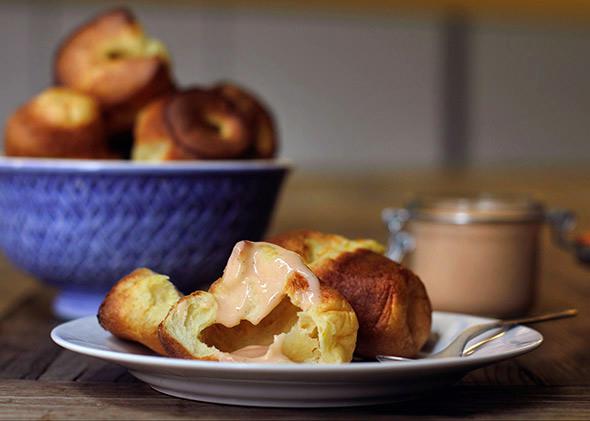The first time I made curd was on New Year’s Eve a few years ago when I had decided to host a festive dinner for friends. That month’s Martha Stewart Living had featured a gorgeous recipe for a holiday showstopper called “Lemon-Mascarpone Crepe Cake,” and if Dec. 31 isn’t an evening fit for showstoppers, I don’t know what is. So early in the day, I made the curd—a standard lemon affair, piquant and pure with nothing more than egg, sugar, butter, and fresh lemon juice melded into a loose custard, its luxurious, almost velvety texture disguising the simplicity of its construction. Then I moved on to the crêpes, which would be layered with the curd to build the cake, and as one hour of crêpe cooking passed into two and then three, the elegance of the intended result paled in comparison to the effort. As I swirled the final bit of crêpe batter around the pan, I resolved that the cake would remain in the realm of special occasions—but the curd was another matter entirely. I wanted to encounter its creamy goodness throughout the year.
So let’s arrange a rendezvous now. Curd is one of those dishes that should take on the flavors of the season, so we’ll leave the classic lemon aside (except for two brightening and custard-stabilizing tablespoons) and instead take advantage of the last of the rhubarb crop, which is just finishing its run in the farmers’ markets and CSAs of many parts of the country. An ideal rhubarb curd possesses both the floral, somehow dewy flavor of the rhubarb and a charming pink hue that lives up to summer’s bright palette.
Unburdening the rhubarb stalks of their juice is a bit more involved than squeezing a lemon, but the extraction process offers us the opportunity to heighten the vegetable’s floral qualities by simmering it with orange peel and vanilla bean. An optional splash of elderflower liqueur at the end of the cooking process takes the whole thing right into grandma’s flower garden, which should be in full bloom about now.
But before we are carried away in this idyll, I must note that my tests revealed that if it is a rosy pale pink we are after in this curd, the red pigments in the rhubarb—you should choose the reddest ones you can find—are not alone enough to overcome the yellow of the eggs. One could add food coloring, I suppose, but why toy with synthetic compounds when half a beet simmered with the stalks will do an even better job? And speaking of eggs, know that there is vigorous debate within the curd community about how many yolks versus whole eggs one should use. Some recipes call for only yolks while others include the whites alongside. I favor a lighter, fluffier, and more spreadable curd and so have incorporated two whole eggs here. If you wish to futz with the consistency, remember that one egg is roughly equivalent to two yolks, liquid-wise.
Once you’ve produced this blushing, vanilla-speckled dream, you can use it everywhere a sweet note is welcome. Desserts, ranging from layer cakes and mousse (just fold the curd with whipped cream) to cookies or ice cream, are a natural home. But my favorite meeting time is over breakfast or tea, where curd makes the most endearing conversation with toast, oatmeal, scones, muffins, or, as I have shown it here, with orange popovers. Keep a jar of this stuff on hand, and you’ll never be caught by a guest (or by your own sweet tooth) unprepared, no matter the day or time.
Rhubarb Curd
Yield: 2 cups
Time: About 30 minutes
2 cups chopped fresh rhubarb (about 6 stalks)
1 vanilla bean
3 strips orange peel, roughly 3 inches by 1 inch
½ medium beet, peeled
¾ cup sugar
4 large egg yolks
2 large eggs
2 tablespoons freshly squeezed lemon juice
½ teaspoon salt
6 tablespoons unsalted butter
1½ teaspoons elderflower liqueur, such as St. Germain (optional)
1. Put the rhubarb in a medium saucepan with enough water to cover it by about ½ inch. Split the vanilla bean with a paring knife and scrape the seeds into a small bowl. Add the vanilla bean pod, the orange peel, the beet half, and ¼ cup of the sugar to the pot. Bring to a simmer over medium heat and cook, stirring occasionally, until the rhubarb has mostly disintegrated, about 15 minutes. Remove and discard the vanilla pod, orange peel, and beet, and press pulp against a metal strainer placed over a large measuring cup to extract as much liquid as possible. Discard the solids.
2. Bring a medium pot of water to a simmer over medium heat. Put the remaining ½ cup sugar, the egg yolks, the eggs, the lemon juice, the salt, and the reserved vanilla seeds in a medium steel or glass bowl that will fit over the pot, and whisk to combine. Gradually whisk in 1¼ cups of the rhubarb juice (reserve any extra for cocktails or another use), then set the bowl over the simmering water. Cook, beating constantly with a whisk, until the mixture has thickened enough to loosely coat the back of a wooden spoon, 8 to 10 minutes.
3. Remove the bowl from the pot and whisk in the butter, 1 tablespoon at a time, waiting until each pat has melted before adding the next. Whisk in the elderflower liqueur, if using. If the curd seems lumpy, strain it through a mesh sieve. Allow to cool and then refrigerate until chilled, at least 4 hours, before serving. Store leftover curd in an airtight container in the refrigerator for up to a week.
Previously in You’re Doing It Wrong:
Raspberries
Pancakes
Biscuits
Scones
Banana Pudding
Lemon Bars
Crème Brûlée
